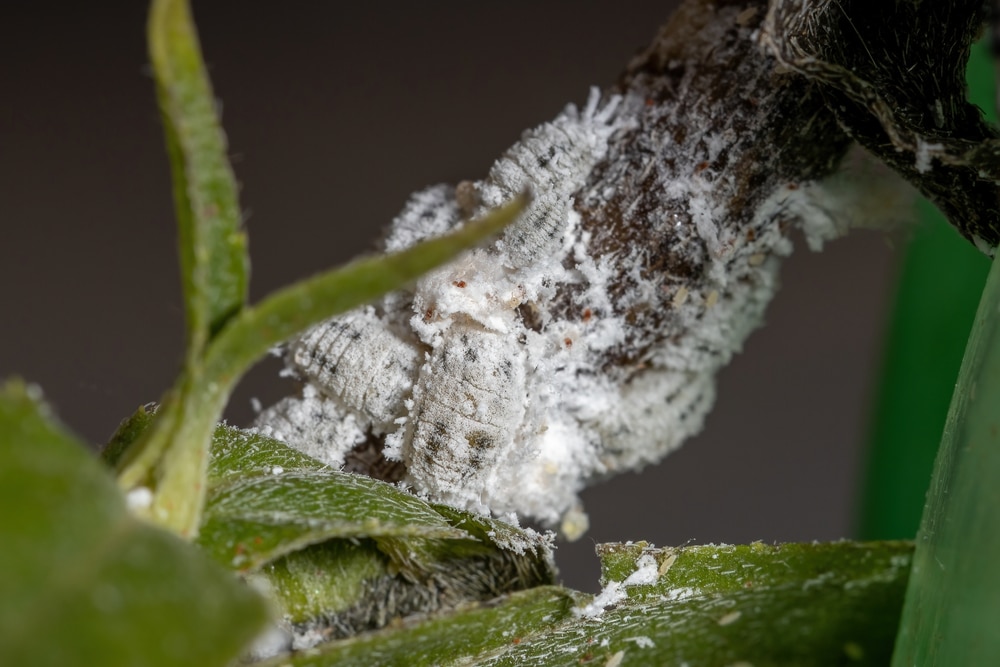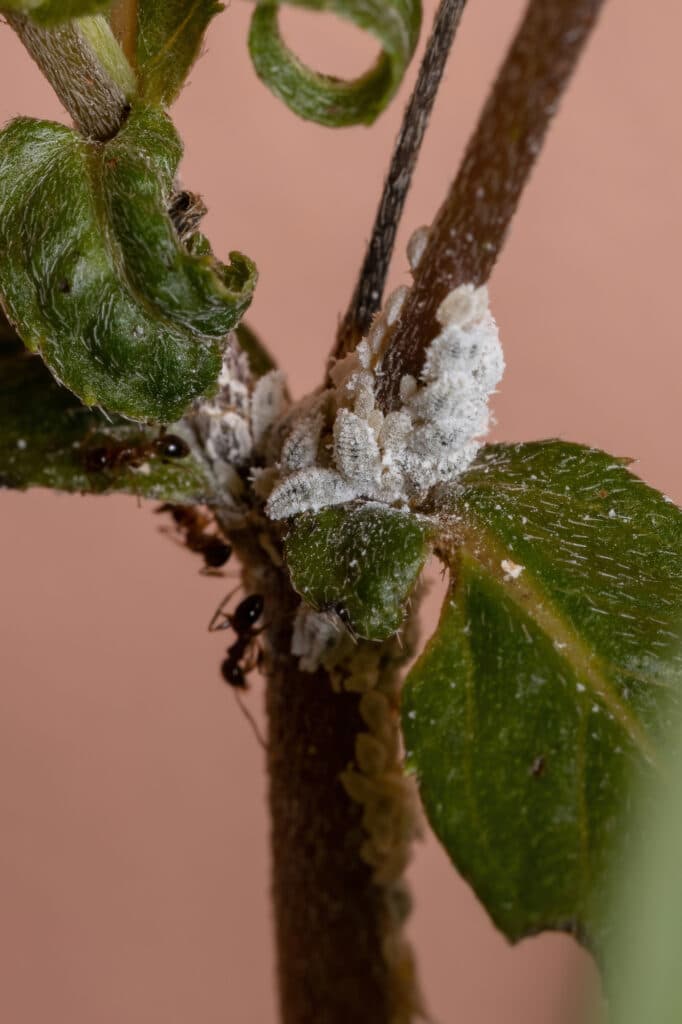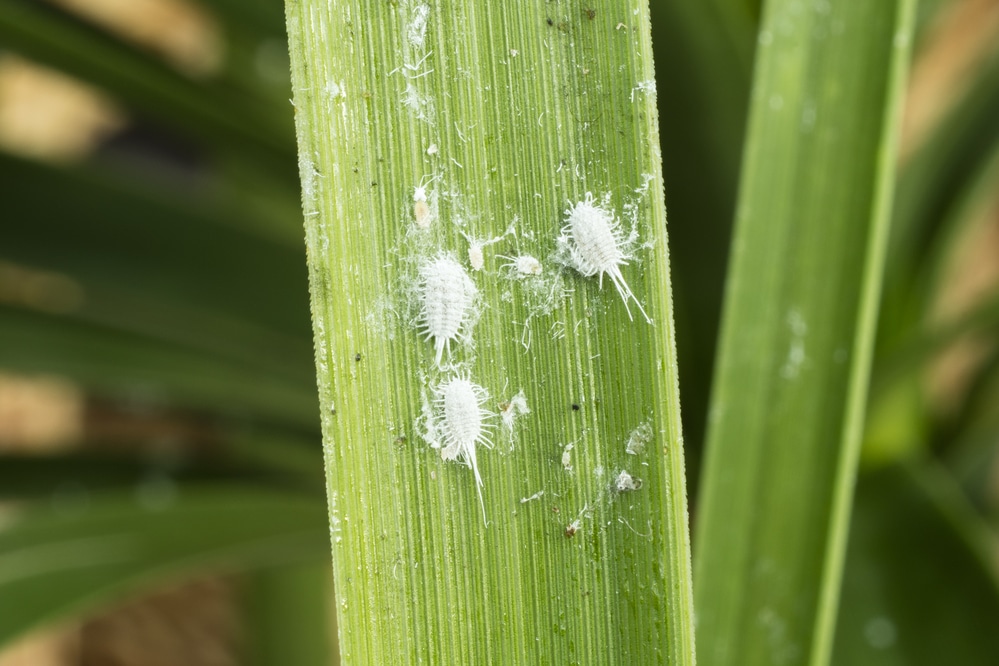Nothing strikes horror into the heart of a houseplant aficionado quite like the discovery of a pest population lurking ominously amongst the foliage of our most beloved plants. Frustratingly, there are all manner of diverse and problematic pests with the potential to attack and harm our indoor plants, and the threat of an invasion is a constant worry for most indoor gardeners.
Some of the most commonly found pests on houseplants are mealybugs. These are tiny insects that feed on the sap of the host plant, exhausting its nutrients and weakening the plant over time. Mealybugs are notoriously difficult to treat since they are resistant to most chemical pesticides. They also reproduce incredibly quickly, meaning time is of the essence when dealing with a mealybug infestation.
If you’ve discovered mealybugs on your cherished Calathea or your most prized Pothos, don’t despair! Following this comprehensive guide to getting rid of mealybugs will help you nurse your plants back to full, flourishing health in no time.
What Are Mealybugs?
Mealybugs are scale insects belonging to the Pseudococcidae family. There are over 2000 known species of mealybugs. They are usually polyphagous, meaning they feed on a variety of different plant species, so can pose a threat to most indoor plants.
Mealybugs are very small, rarely exceeding 4 millimeters in length. They have oval-shaped bodies and are often white in color, with a waxy residue covering their bodies. This waxy covering often appears powdery or fluffy.
Infant mealybugs will move around the plant, but adult females generally become immobile once they find a suitable position to feed, whilst males have wings and can fly. The males exist solely to fertilize the eggs and never feed on the plants. Females can lay anything between 100 and 600 eggs at a time, so you can imagine how quickly a small infestation can spread if left unchecked!

What Environments Do Mealybugs Like?
Mealybugs love warm, moist conditions, so they are rarely found on outdoor plants. Unfortunately, this means that plants grown indoors in warm temperatures provide the perfect environment for mealybugs to flourish, particularly as there are no natural predators like lacewings or ladybugs inside, who would naturally keep mealybug populations at bay.
Mealybug infestations can take hold at any time of year, but they are more common during the spring and summer when the temperature is warmer and the air is more humid. They like to hide in the sheltered crevices, cracks, and nooks of a plant, often nestling away in thick foliage or on the undersides of leaves. Sometimes they will even sneak into the root system of the host plant beneath the soil.
Mealybug Prevention
Mealybugs love moisture, so overwatered plants are a haven for these pests! Overfeeding can also entice mealybugs since they love nitrogen-rich conditions and they will reproduce much faster when high concentrations of nitrogen are present.
New plants, particularly those which have come from a crowded greenhouse or nursery are at a high risk of harboring mealybugs. Before you purchase any new plant, inspect it thoroughly for any signs of pests or disease. Even if it seems healthy, it’s easy to miss very early signs of mealybug infestations, so it’s always a good idea to quarantine new plants for up to a month before introducing them to your wider collection, just in case any hidden nasties have been lurking unnoticed.
It’s important to inspect all your plants regularly to look for any early signs of pests so that you can act quickly to deal with the problem. Catching an infestation in the early stages greatly improves the chances of salvaging your plant.
Semi-regular neem oil treatments are a great preventative measure against mealybugs, especially if your plants’ environment is particularly humid and warm. Simply dilute the neem oil in water and wipe over the foliage.
Plants that are healthy and thriving are generally far less susceptible to mealybug infestations, so ensuring your plants are happy and their needs are met is paramount to preventing pests.
Mealybug Symptoms
Since the eggs and nymphs are so tiny, it may take a while before you notice any visible signs of infestation. Often, the first sign that mealybugs are present is the appearance of a white cottony or fluffy substance on the undersides of leaves which is deposited by mature bugs. This substance is the waxy protective coating that covers the bugs.
Mealybugs attack and weaken the host plant by inserting their long, needle-like mouthparts into the foliage and sucking out the nutrient-rich sap. Through this feeding process, the bugs secrete a sticky substance known as honeydew, which eventually will become visible on the leaves as shiny, tacky patches.
These honeydew secretions can become a breeding ground for a secondary disease, Sooty Mold, where black fungus begins to grow from the sticky honeydew, leaving an unsightly black residue on the foliage and preventing the plant from photosynthesizing sufficiently, eventually stunting growth.
Most healthy plants will be able to survive a small mealybug infestation with early intervention and a diligent treatment regime. Problems arise, however, when infestations become very large, or if an infestation is left to continue untreated, as the plant can soon become overwhelmed. The most obvious symptom of a mealybug infestation is leaves yellowing, curling, and dropping as the plant gradually becomes weaker due to its nutrients being depleted by the pests. If the infestation is allowed to proliferate unchecked, the plant will become unable to support itself because of the nutrient loss, and will eventually die.
How to Get Rid of Mealybugs
Here are a few Mealybug treatment option if you find out that your houseplants are infested:
Quarantine
The first, and most important, course of action for any plant you suspect of having a mealybug infestation is to immediately isolate and quarantine it away from any other plants. This stops the mealybugs from spreading from plant to plant. Whilst treating a mealybug infestation, you should only water the plant sparingly, as excess moisture will only exacerbate the problem.
Rinsing
During the very early stages of infestation, you may want to try simply rinsing the plant under tepid running water, in the shower for example. Be sure to thoroughly clean each leaf and stem, washing away all the visible signs of pests.
Pruning
Remove any affected leaves and stems with sterilized shears and dispose of the cuttings. As with any pest infestation, it’s also good practice to repot the plant and change the soil in case any bugs are lurking dormant beneath the surface.
Isopropyl Alcohol
Isopropyl alcohol of 70% or lower is a relatively safe and effective treatment against mealybugs. It isn’t harmful like some chemical or synthetic pesticides, and it should kill any adult bugs on contact. For this reason, you must ensure that every single bug comes into contact with the alcohol. Although time-consuming, the best method is to use a cotton bud soaked in alcohol and thoroughly wipe over each leaf, crevice, and stem. Unfortunately, isopropyl alcohol won’t kill the eggs or larvae, so you will need to repeat the process regularly over a number of weeks to truly disrupt and destroy the population.
If you don’t have any isopropyl alcohol to hand, some people have reported similar success treating mealybugs by using vodka or gin as an alternative, although this may not be the most scientific method of treatment!
Insecticidal Soap
There are a number of insecticidal soaps available to buy to treat mealybugs, or you can make your own at home which should be just as effective. Insecticidal soaps are non-toxic to humans and animals, but the soapy ingredient can harm plants if used in too high a concentration. The soap clings to the mealybugs, breaking down their waxy barrier and eventually suffocating them.
To make your own homemade insecticidal soap, mix gentle, fragrance-free dish soap with water at a ratio of around one teaspoon of soap per gallon of water. You can either spray the solution onto the plant or apply it with a cotton bud. Make sure that every part of the plant is covered with the soap, as like with isopropyl alcohol, the soap solution needs to make contact with the mealybugs to kill them.
Leave the solution on the plant for a few hours, before rinsing thoroughly. It’s best to apply soap sprays in the morning or evening when the temperature is cool, as they can harm the plant if applied during very hot temperatures.
Neem Oil
Neem oil is a fantastic natural and non-toxic pesticide, so it won’t harm plants, animals, or humans. Neem oil concentrate is readily available to purchase, and you should always follow the dilution instructions on the packaging before applying it to your plants. It works by disrupting the bugs feeding cycles, preventing the larvae from progressing into adults, as well as smothering the adults, and causing them to suffocate. You should either spray or wipe the entire plant thoroughly, including stems, with diluted neem oil. It can take several days for neem oil treatments to begin to work, so you will need to reapply regularly.
Neem oil has the added benefit of being anti-fungal, so it helps to prevent sooty mold from taking hold where honeydew is present. Even better, neem oil treatments offer residual protection against future infestations, something that isopropyl alcohol and insecticidal soaps don’t offer.
Chemicals
Chemical-based synthetic pesticides are generally not very effective in treating mealybugs, as their waxy covering will repel the chemicals. Mealybug populations can also become resistant to pesticidal chemicals, particularly when plants have suffered from recurring infestations and the bugs have been exposed to the chemicals repeatedly. It is not always advisable to use chemical pesticides on indoor plants since they can often contain toxins that are harmful to both humans and animals living in the home.

Tips for Successful Mealybug Treatment
Remember, whenever you are applying any pesticide or insecticide to a plant, always test it on a small area of the plant first. Wait a couple of days to see if there are any adverse effects before treating the whole plant.
Depending on the severity of the infestation, you may need to employ a combination of methods to have any real effect. And you will almost certainly need to repeat the treatment process every few days for several weeks before the bugs finally start to die off completely.
The plant should remain in quarantine for at least a month once all signs of infestation have subsided, just to be on the safe side. After all your hard work, the last thing you want to do is reintroduce another infestation from any remaining, hidden mealybugs.
Disposal
Sadly, mealybugs infestations can sometimes become overwhelming, with no amount of treatment having any meaningful effect. In these cases, it’s best to dispose of the plant completely to prevent the bugs from spreading to other plants.
Frequently Asked Questions
Here are a few of the most common questions that we hear about getting rid of mealybugs:
How Long Do Mealybugs Live?
The life cycle of a mealybug is relatively short, with most reaching maturity within six to eight weeks after hatching. Females will die after laying their eggs, but mealybugs can reproduce all year round, so there is potential for a perpetual cycle of eggs, larva, and adults if infestations are left untreated.
Are Mealybugs Toxic?
Luckily, mealybugs aren’t necessarily toxic or harmful to humans. However, some people can experience skin sensitization and irritation if they have an allergy to the honeydew that the bugs produce, causing rashes, sinusitis, eye irritation, and itchiness. Mealybugs don’t tend to cause harm to animals either, but chemical pesticides used to treat mealybugs can be harmful to pets.
What Plants are Most Susceptible to Mealybugs?
Mealybugs exhibit polyphagia, meaning that they will feast on a wide variety of plants, and are not just limited to any one species. Some plants are more susceptible than others though. Mealybugs particularly enjoy feasting on plants like Hoyas, Orchids, Cacti, Philodendrons, Palms, and Citruses. These plants should be monitored closely for any signs of infestation, particularly during the warmest months.


I had an asparagas fern that became infected over the winter. I moved it to the master bath.
After wiping off white spots, and pruning off infested leaves/stems with soapy water with no improvement, I resorted to bactine first aid spray. ( didn’t have any rubbing alcohol) I sprayed white spots heavy and then rest of plant lightly. Allowing 3-4 days between spraying. Then waited about 3 weeks to see if they returned. Repeated treatment. Plant did not have an adverse reaction to the bactine while mealybugs disappeared and so far haven’t returned on that plant.